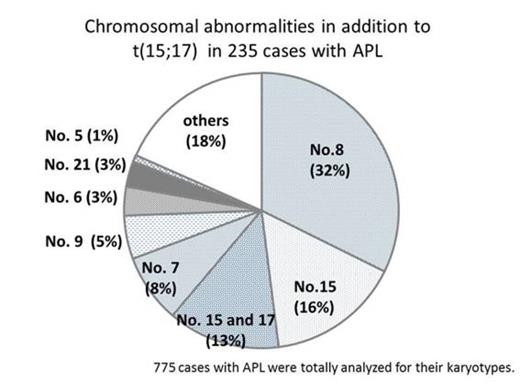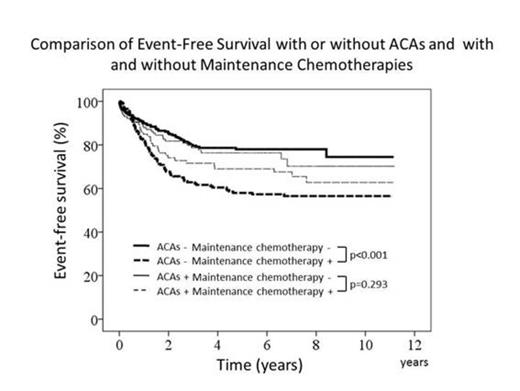Abstract
Background: A combination of all-trans retinoic acid (ATRA) and chemotherapy (CT) has dramatically improved the prognosis of acute promyelocytic leukemia (APL). Nevertheless, considerable number of patients are either refractory to the treatment or relapse after an initial complete remission (CR). Although prognostic factors for APL have been studied, the influence of chromosomal variations in addition to t(15;17) remains controversial. One of the reasons is due to the numbers of cases studied were relatively small (47 to 513 cases). Here, we analyzed clinical features and outcomes of 775 APL caseswith or without additional chromosome abnormalities (ACAs) who were treated with ATRA and CT in the JALSG-APL studies including a large number of cases analyzed for karyotype.
Methods: 1,024 cases aged between 15 and 70 yrs with newly diagnosed APL were enrolled in the JALSG APL92, 95, 97 and 204 studies and 775 patients were assessable for karyopypes. All protocols included induction therapy with ATRA and CT, following several courses of post-remission chemotherapy including anthracyclines. Arsenic trioxide (ATO) was not included. Clinical and biological characteristics such as age, gender, initial leukocyte count, platelet count, number of APL cells, DIC score, lack of Auer-rod and incidence of variant type were analyzed in relation to chromosomal abnormalities in 766 cases. CR rate, relapse rate (RR), overall survival (OS), event-free survival (EFS), and disease-free survival (DFS) were assessed and compared between patients with or without ACAs. Each variation of ACAs was also analyzed with clinical and biological features. This work was supported in part by the National Cancer Center Research and Development Fund (26-A-24), Grants-in-Aid from the Cancer Research from the Japanese Ministry of Health, Labor and Welfare (#23-004 and #25100501). These studies were approved by our IRB.
Results: ACAswere noted in 235 patients (30%). Sanz score and the initial leukocyte count were significantly lower in patients with ACAs (p=0.027 and p=0.027, respectively). No other clinical or biological differences were found between patients with and without ACAs. The subgroups of ACAs were shown in Figure 1. Trisomy 8 was found in 76 cases (32%). Other ACAs were found involving chromosome 15 in 37 cases (16%), both chromosomes 15 and 17 in 31 cases (13%), chromosome 7 in 19 cases (8%), chromosome 9 in 12 cases (5%), chromosome 6 in 8 cases (3%), chromosome 21 in 7 cases (3%) and alternative ACAs in 43 cases (18%). A low initial leukocyte count (<3,000/µl) was significantly associated with an abnormality of chromosome 15 (p=0.039) and a high initial leukocyte count (≥10,000/µl) was associated with other unspecified chromosomal abnormalities (p=0.010). In all cases, CR rate, OS, EFS and DFS were not different between patients with and without ACA (p=0.341, p=0.694, p=0.414, p=0.852, respectively). However, in elderly patients (≥50 yrs) with ACAs, OS, EFS and DFS were significantly lower compared to younger patients (<50 yrs) (p=0.019, p=0,023 and p=0.030, respectively) (Figure 2). No such age related difference was observed for patients without ACAs (OS, p=0.068; EFS p=0.485; DFS, p=0.672). In each risk group divided by initial leukocyte count, clinical outcomes were not different between patients with and without ACAs. In patients without ACAs, OS, EFS and DFS of patients assigned to no maintenance or retinoid maintenance were significantly better than in those allocated to the maintenance CT (p<0.001, for all). (Figure 3) The significance was not observed in patients with ACAs except DFS (OS, p=0.161; EFS p=0.293; DFS p=0.043).
Conclusions: The present study is the largest to date to focus on the influence of ACAs on clinical outcomes of patients with APL treated with ATRA and CT. The analysis revealed exact variation and frequency of ACAs. We found that patients with ACAs were associated with the lower initial leukocyte count and the lower survival outcomes in elderly patents, suggesting a possible link to age and post-remission chemotherapy. Some promising agents, such as ATO, tamibarotene and gemtuzumab ozogamicin might change the prognostic factors, including ACAs. Careful chromosomal analyses, especially ACAs related to chromosome 15 and/or 17, need to be analyzed by molecular methods and performed in future prospective studies with alarge number of cases.
Kiyoi:Bristol-Myers Squibb: Research Funding; Chugai Pharmaceutical Co. LTD: Research Funding; Kyowa Hakko Kirin Co. LTD.: Research Funding; Dainippon Sumitomo Pharma: Research Funding; Zenyaku Kogyo: Research Funding; FUJIFILM Corporation: Research Funding. Kobayashi:Ohtsuka: Research Funding; Behringer: Research Funding; Simic: Research Funding. Asou:Chugai Pharmaceutical Co., Ltd.: Research Funding. Miyazaki:Nippon-Shinyaku: Honoraria.
Author notes
Asterisk with author names denotes non-ASH members.




